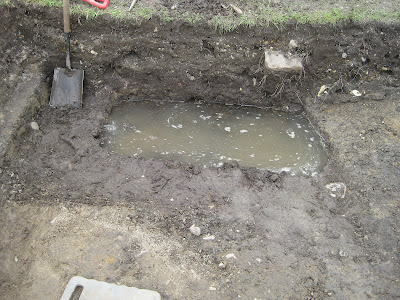Our trench continues to play some tricks on us. Here is a nice view first thing in the morning, when one of our supervisors had done stalwart work coming early and clearing out a bunch of the dark backfilled 1930's trench.
Unfortunately, continued excavation of the fill unleashed a remarkable torrent of water cascading into the trench! The whole site is wet, but this was very unusual....some kind of capped off underground channel was unleashed and water poured in at about twice the rate of a garden hose. Shortly we had this:
What you can't really appreciate from this picture is that the water was about a foot and a half deep in the excavated area. Bailing buckets and running a pump reduced the water level a bit, but it continued to threaten the rest of the trench, and troweling deeper into the undisturbed layer became problematic.
This certainly, and literally, put a damper on the day, but I did find one thing I rather like. It is a bit of broken Samian ware pottery with a naked gladiator on it.
A few other items coming to light on other areas of the site. Here is an interesting one:
This appears to be a cooking pot, or at least a good portion of it. Is the brownish residue the remains of its final contents?
Weather forecast seems....ok tomorrow but wetter on Friday. As the entire site is presently "water challenged" it is possible that the Vindolanda updates will end early. But, two days to go!




3 comments:
For some reason that pottery shard with the gladiator figure very much highlights the marvelous and ordinary. It's Romans and Gladiators!! But it's just a bit of everyday pottery, probably thrown out after it was broken. As you pointed out with the shard of crosshatched tile a day or so ago, looks like it could have been made yesterday.
Out of curiosity, has the Vindolanda site ever been subjected to searches by modern radar / magnetic scans? Or whatever type of high tech scan, I barely know what I'm talking about; only that in some places you can get an idea of What Lies Beneath using various scanning & imaging tech.
TK
There are indeed "geo phys" images of the place. But with succesive forts and villages for 400 years, then unclear Dark Age occupation, then modern farming including placement of Victorian era field drains, well, its an impenatrable mess to work from.
One area I was put on two years ago looked like a marvelous new foundation, perhaps to a temple. Nope, just a low area filled in with boulders. And often very interesting things are found in areas of little geo phys interest.
Its a tool that helps steer archeology, but in its current form it has many limitations.
T
Got it.
You know what's crazy? I just realized that I've been to Vindolanda. Way back in the late summer of 1987. I was spending some time with a family outside Hexham.
Should've been obvious; I've been poking my head in here for ages. Thought that name was familiar, but but it didn't click.
We took a spontaneous day trip to visit Roman sites - Hadrian's Wall, etc. I honestly don't remember too much about Vindolanda itself. I don't recall any sort of facility like what's shown on the Vindolanda website; or maybe it wasn't open.
I think there were some signs and such and we just walked out to it. But we visited several places that day and they all involved taking a walk.
I do remember that the Matron of the family knew that there was an active dig at one of the sites and she hoped they would be working when we got there; no such luck.
Mostly the trip was an excuse to walk and take in some countryside. Beautiful around there, especially where I stayed near Hexham.
Post a Comment